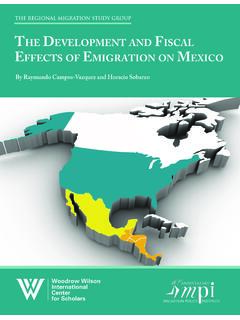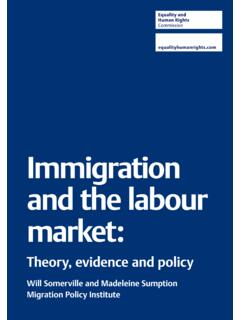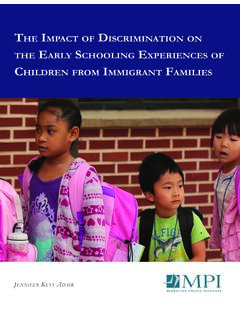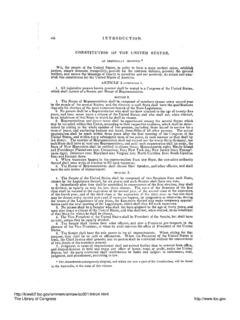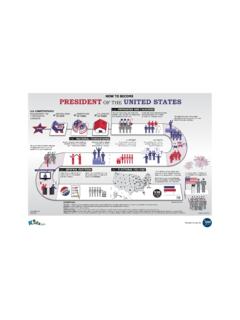Transcription of MAJOR US IMMIGRATION LAWS, 1790 - PRESENT
1 1790 The 1790 Naturalization Act (1 Stat. 103) establishes the country s first uniform rule for naturalization. The law provides that free white persons who have resided in the united states for at least two years may be granted citizenship, so long as they demonstrate good moral character and swear allegiance to the Constitution. The law also provides that the children (under 21) of naturalized citizens shall also become US congress enacts four laws known collectively as the Alien and Sedition Acts, which contain a number of stringent IMMIGRATION enforcement provisions. Among other provisions, the laws require that noncitizens have resided in the united states for 14 years prior to naturalization, authorize the President to apprehend, restrain, and remove noncitizens who are citizens or subjects of countries with which the united states is at war, and allows the Executive Branch to deport any noncitizen deemed dangerous to the peace and safety of the united states .
2 congress eventually repeals the naturalization provisions in 1802 and the other portions of the laws are permitted to expire. 1864 The IMMIGRATION Act of 1864 (13 Stat. 385) establishes the position of the Commissioner of IMMIGRATION , who will report to the Secretary of State, and provides that labor contracts made by immigrants outside the united states shall be enforceable in the US congress enacts the IMMIGRATION Act of 1882 (22 Stat. 214), constituting one the first attempts at broad federal oversight of IMMIGRATION . The law levies a tax of 50 cents for each passenger arriving by ship from a foreign port who is not a US citizen, to be paid by the ship s owner. The proceeds are deposited into a fund in the US Treasury called the IMMIGRATION fund, which the Treasury Secretary is authorized to use to defray expenses incurred in regulating IMMIGRATION .
3 The law further establishes that the united states will screen arriving passengers and that anyone deemed a convict, lunatic, idiot, or person unable to take care of himself or herself without becoming a public charge shall not be allowed to land. MAJOR US IMMIGRATION LAWS, 1790 - PRESENTM arch 2013U S iM M i g r a t i o n re f o rMTimelineMajor US IMMIGRATION Laws, 1790 - PRESENT congress passes the first Chinese Exclusion Act (22 Stat. 58), the united states first attempt at regulating IMMIGRATION along racial lines. The law suspends the IMMIGRATION of Chinese laborers for ten years, but allows those Chinese who were in the united states as of November 17, 1880 to remain. The 1882 law paves the way for a series of laws between 1882 and 1904 that severely restrict Chinese IMMIGRATION flows and provide for the deportation of many Chinese nationals already residing in the united states .
4 1888 The 1888 Scott Act further restricts Chinese IMMIGRATION by prohibiting lawfully residing Chinese nationals who departed the united states from returning, even when such nationals previously received certificates authorizing their re-admission. The following year, the Supreme Court upholds the constitutionality of the Scott Act in Chae Chan Ping v. united states (130 581). 1891 A law signed by President Benjamin Harrison on March 3, 1891 (26 Stat. 1084) makes it a federal misdemeanor to bring into the united states or aid in bringing into the united states any noncitizen not lawfully entitled to enter. It also establishes the position of a federal superintendent of IMMIGRATION situated within the Treasury Department. 1892 congress passes the Act to Prohibit the Coming of Chinese Persons into the united states (27 Stat.)
5 25), known as the Geary Act. The law extends the prohibitions of the 1882 Chinese Exclusion Act for an additional ten years and requires all Chinese nationals residing in the united states to obtain certificates indicating their lawful presence. The law also provides that any Chinese national who is found residing in the united states unlawfully may be imprisoned and sentenced to one year of hard labor. In the landmark 1896 IMMIGRATION case Wong Wing v. united states (163 228), the Supreme Court strikes down the hard labor provision as unconstitutional under the 5th Amendment. 1917 The 1917 IMMIGRATION Act (39 Stat. 874) draws on the prohibitions of the Chinese exclusion laws and creates an Asiatic barred zone covering British India, most of Southeast Asia, and almost all of the Middle East. Nationals from countries within the zone are prohibited from immigrating, though the law exempts students, as well as certain professionals ( teachers, government officers, lawyers, physicians, and chemists), and their wives and children.
6 The law also expands the list of grounds of inadmissibility to include, among other grounds, anarchists, persons previously deported who seek re-entry within a year without obtaining special permission, and all individuals over the age of 16 who are deemed physically capable of reading and who cannot read. 1921 The 1921 Emergency Quota Act constitutes congress first attempt to regulate IMMIGRATION by setting admission quotas based on nationality. The law limits the number of immigrants of each nationality allowed to immigrate to the united states TimelineMigration Policy Instituteeach year to 3 percent of the number of foreign-born persons of that nationality PRESENT in the united states as of the 1910 census. Temporary visitors, government officials, and nationals of Western Hemisphere countries are excluded from the The 1924 National Origins Quota Act (known as the Johnson-Reed Act) establishes that quotas will be calculated based on 2 percent of each nationality s proportion of the foreign-born US population in 1890, as indicated in the 1890 census.
7 The use of the 1890 census to set the quotas is criticized as discriminating against southern and eastern Europeans, who arrived in the united states in greater numbers during the last decade of the 19th century and the first two decades of the 20th century. Students, nationals of Western Hemisphere countries, members of certain professions, and the wives and minor children of US citizens are exempted from the Prompted by labor shortages in the united states as a result of World War II, the united states and Mexico enter into the 1942 Bracero Agreement, allowing Mexican nationals to enter the united states to serve as temporary agricultural workers. The agreement, which congress extended in 1949 and 1951, provides that US employers will pay the transportation and living expenses of Mexican laborers, as well as wages equal to those of American farmworkers doing similar work.
8 The program continues in some form until 1964. Sixty years after the first Chinese Exclusion Act, the Magnuson Act (57 Stat. 600) repeals the Chinese Exclusion Acts and allows Chinese nationals to become US The War Brides Act (59 Stat. 659) authorizes the admission of the foreign-born spouses and children of US citizens serving in or honorably discharged from the armed forces during World War II. 1948 The Displaced Persons Act of 1948 (62 Stat. 1009) allows over 200,000 individuals displaced from their homelands by Nazi persecution to immigrate to the united states . The law also states that up to 15,000 individuals residing in the united states as of April 1, 1948 who meet the displaced person definition may adjust their status and become lawful permanent residents. President Truman signs the law with very great reluctance, expressing concerns that the law s requirements will exclude many Jewish refugees.
9 1952 The IMMIGRATION and Nationality Act (known as the McCarren-Walter Act) (182 Stat. 66) consolidates several IMMIGRATION laws into one statute, and preserves the national-origins quota system (though the law updates the way in which the quota is calculated). For the first time, Asian nations are assigned quotas that allow their nationals to immigrate to the united states . The new law also establishes that US consular officers will screen foreign nationals for admissibility to the united states , and that officers will not issue visas to individuals found inadmissible. U S iM M i g r a t i o n re f o rMMajor US IMMIGRATION Laws, 1790 - PRESENT 1953 The Refugee Relief Act of 1953 (94 Stat. 102) authorizes the admission of up to 205,000 non-quota immigrants who are fleeing persecution or have been expelled from their homes in Europe.
10 1962 President John F. Kennedy signs the Migration and Refugee Assistance Act of 1962 (76 Stat. 121), which authorizes funds to assist foreign nationals from the Western Hemisphere who have fled their countries of origin because of persecution or a fear of persecution on account of race, religion, or political opinion. The law is intended to assist Cuban nationals fleeing The 1965 IMMIGRATION and Nationality Act (known as the Hart-Cellar Act) (79 Stat. 911) abolishes the national-origins quota system and replaces it with a system whereby immigrants are admitted based on their relationship to a US citizen or lawful permanent resident family member or US employer. While caps are placed on the total number of immigrants who may be admitted each year in most family-based and employer-based categories, the law provides that there will be no cap on the number of immediate relatives (spouses, parents, and minor children) of US citizens admitted each year.






